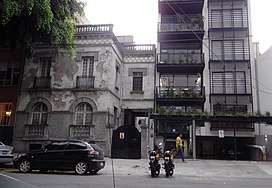Gentrified architecture
Gentrified architecture is an architectural style which has been identified as homogenizing, overbearing (in reference to massing), lacking imagination or character, and disconnected from the social histories in which it exists.[1] Gentrified architecture is often compared with the style of architecture preexisting the process of gentrification in a particular location. As a result, its presence has been described by Maria Nicanor as producing “two very different dynamics and two very different futures.”[1] The architectural style has been identified as a marker of borders between communities and a site of racialized hostilities.[2][3]

Effects
Gentrified architecture has been described as transformative and obliterating because it does not modify or build from an existing architectural tradition of an area, but rather changes it completely.[4][5] The presence of gentrified architecture produces both material and symbolic changes to an area, shaping collective perceptions and altering behaviors. An area once "strongly associated with the working class," which may be perceived by outsiders as "unsafe" or "dangerous," may shift with the presence of gentrified architecture. For outsiders, it brings a new heroic "innovative," "forward-looking," and "cool" identity to a location.[4][6][7]
Reception
Gentrified style has received mixed reception. Gentrified architecture has been described by academics as embodying a "haunting predictability" that is "replicated from city to city."[2] Michael Sorkin refers to it as "urban renewal with a sinister twist, an architecture of deception which, in its happy-face familiarity, constantly distances itself from the most fundamental realities."[5]
Houston architect Ben Koush describes gentrified style buildings as follows: "I think they’re ugly, but I also realize that they’re following the requirements of the market. What is upsetting is that people made lives for themselves, and then the middle-class white people want to move back in and claim the territory for themselves and push those people out."[1] Maria Nicanor refers to the buildings as creating "a rampant sense of single-family homogeneity entirely devoid of any imagination and disconnected from the realities of families and how they age."[1]
References
- West, Allyn (5 March 2020). "Baffled City: Exploring the architecture of gentrification". Texas Observer. Retrieved 21 June 2020.
- Harrison, Sally; Jacobs, Andrew (2016). "Gentrification and the Heterogeneous City: Finding a Role for Design". The Plan. 1. doi:10.15274/tpj.2016.01.02.03.
- Badger, Emily (3 May 2019). "Unlocking the (Neon Green) Door to Gentrification". The New York Times. Retrieved 22 June 2020.
- Solgaard, Kristine Høglund (2004). "On Gentrification: Commercial Businesses and Cultural Institutions in Old Oslo". Norwegian Open Research Archives: 79–81 – via CORE.
- Sorkin, Michael (1992). Variations on a Theme Park: The New American City and the End of Public Space. Macmillan. pp. xiv–xv. ISBN 9780374523145.
- Odih, Pamela (2019). Adsensory Urban Ecology. Cambridge Scholars Publishing. p. 158. ISBN 9781527531239.
- Jacobs, Karrie (16 October 2017). "The High Line Network Tackles Gentrification". Architect Magazine. Retrieved 22 June 2020.